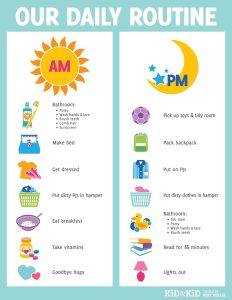Can you imagine a life without a calendar, diary or phone reminder? How would we keep track of our appointments, places we are expected to be or what our to-do list is each day? Not having a routine can lead to feelings of anxiety and uncertainty, therefore affecting the way we are able to efficiently complete tasks of daily living.
Establishing a structured routine with a visual schedule can be a helpful tool to support children’s emotional regulation, and manage anxiety and their understanding of situations.
What is a Visual Schedule?
A visual schedule is used to enhance children’s understanding of the upcoming plan and give them a sense of predictability. It provides sequential information addressing the steps within a desired activity, the day, week or month in the vibrant form of images.
The Benefits of a Visual Schedule
- Provides predictability and structure.
- Assists children with transitioning between tasks.
- Promotes emotional regulation in children, who may otherwise display feelings of anxiety.
- Allows children to be more self-sufficient in moving between activities with the guidance of a schedule, rather than relying on others to prompt them.
- Teaches the concept of first, then, next and last.
- Develops the child’s independence and reinforces the habit of seeking information.
- Can be used in a variety of settings – home, kindy and school.
- A fun way for children to learn a routine.

www.lambertslately.com
So, how do visual schedules and routines go hand in hand? Aren’t they essentially the same thing? They are very similar, however routines dominate most of our day from the moment we wake up and the time we go to sleep.
Each and every one of us completes a set of tasks throughout the day. This is to ensure we’re remaining productive and taking care of ourselves and those around us. Simple things such as brushing our teeth, getting to and from work, and picking up the kids from school are tasks that Occupational Therapists like to call, Activities of Daily Living (ADL’s) or Daily Living Tasks
Some Examples of Routines for Children May Include:
- Consistent wake-up and bed-time each day.
- Completing morning and afternoon tasks in the same order each day. This can include getting dressed/undressed, showering, toileting and personal hygiene.
- Having an allocated time for homework and screen time.
- Mealtimes.
“Initially, I didn’t know what was available to my daughter and had to educate myself on the key communication points to help build a great plan. The funding has allowed my daughter to learn functional movements such as walking, climbing up steps and riding a tricycle. Now, I couldn’t imagine what life would be like for us without the NDIS. Having support from our LAC provides a great level of security in the complex world of disability. It’s that piece of mind knowing that someone’s got my back when I’m trying to better my child to get off the NDIS in the long run. I also feel empowered to help and encourage others who might be unsure of their first steps with the NDIS. I’m so grateful for the NDIS, we are so lucky that we have a system that can provide assistance for people who have a disability.” – Aisling, parent of a participant with cerebral palsy.





